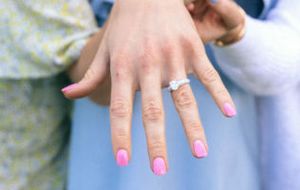Engagement
Wedding
A wedding is a ceremony where two or more people are united in marriage. Wedding traditions and customs vary greatly between cultures, ethnic groups, religions, countries, and social classes. Most wedding ceremonies involve an exchange of marriage vows by a couple, presentation of a gift (offering, rings, symbolic item, flowers, money, dress), and a public proclamation of marriage by an authority figure or celebrant. Special wedding garments are often worn, and the ceremony is sometimes followed by a wedding reception. Music, poetry, prayers, or readings from religious texts or literature are also commonly incorporated into the ceremony, as well as superstitious customs originating in Ancient Rome.
An engagement is a promise to marry, and also the period of time between proposal and marriage - which may be lengthy or trivial. During this period, a couple is said to be affianced, betrothed, engaged to be married, or simply engaged. Future brides and grooms are often referred to as fiancées or fiancés respectively (from the French word fiancé). The duration of the courtship varies vastly.
Long engagements were once common in formal arranged marriages and it was not uncommon for parents betrothing children to arrange such many years before the engaged couple were old enough to marry. In 2007, the average engagement time in the United States was 17 months, but the figure around the world varies greatly depending on culture and customs.
Origin
The concept of an official engagement period in Western culture may have begun in 1215 at the Fourth Lateran Council, headed by Pope Innocent III, which decreed that "marriages are to be ... announced publicly in the churches by the priests during a suitable and fixed time, so that if legitimate impediments exist, they may be made known." Such a formal church announcement of the intent to marry is known as banns. In some jurisdictions, reading the banns may be part of one type of legal marriage.
Engagement rings
The modern Western form of the practice of giving or exchanging engagement rings is traditionally thought to have begun in 1477 when Maximilian I, Holy Roman Emperor, gave Mary of Burgundy a diamond ring as an engagement present.
Customs for engagement rings vary according to time, place, and culture. An engagement ring has historically been uncommon, and when such a gift was given, it was separate from the wedding ring. Romantic rings from the time of the Roman Empire and from as far back as 4 AD often resemble the Celtic Claddagh symbol (two hands clasping a heart) and so it is thought that this was used as some symbol of love and commitment between two people.
In the United States, United Kingdom, Ireland, Canada, Australia, and many other countries, an engagement ring is worn on the fourth finger of the left hand. The tradition of wearing a ring for engagement originated from the Egyptians, who believed the circle was a bond between the two people who were to be married, but was initially first practiced on the fourth finger/ring finger by the Romans, who believed this finger to be the beginning of the vena amoris ("vein of love"), the vein that leads to the heart. The custom in Continental Europe and other countries is to wear it on the right hand; one historical exception arose in monarchical regimes, in which a nobleman entering into morganatic marriage (a marriage in which the person, usually the woman, of lower rank stayed at the same rank instead of rising ranks) would present his left hand to receive the ring (hence the alternative term "left-handed marriage" (Ger. Ehe zur linken Hand).
In other countries from South America, like in Argentina, men and women each use one ring, and these are generally very similar to the wedding rings, with the difference that they are made of silver instead of gold. In Nordic countries such as Finland and Norway, both men and women wear an engagement ring. In Brazil, they are always made of gold, and there is no tradition for the engagement ring. Both men and women wear the wedding band on their right hand while engaged, and, after they marry, they shift the rings to their left hands.
In the modern era, some women's wedding rings are made into two separate pieces. One part is given to her to wear as an engagement ring when she accepts the marriage proposal and the other during the wedding ceremony. When worn together, the two rings look like one piece of jewelry.
Engagement parties
Some engagements are announced at an engagement party, traditionally hosted by the bride's parents. These parties are given in the family's usual style of entertainment. Traditionally, engagement parties were normal parties at which a surprise announcement of the engagement was made by the father of the bride to his guests. Therefore, it is not a traditional gift-giving occasion since no guests was supposed to be aware of the engagement until after their arrival.
In modern times, engagement parties often celebrate a previously publicized engagement. Whether presents are given at these engagement parties varies from culture to culture.
Chat rooms • What links here • Copyright info • Contact information • Category:Root
